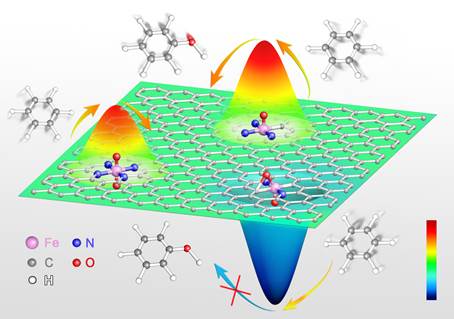| Single-atom Fe catalysts for highly efficiently catalyzed C-H activation —coordination selective regulation |
| From: PublishDate:2020-07-30 Hits: |
Phenol is an important chemical raw material. The direct one-step catalytic oxidation of benzene to phenol is of great significance in the green chemical industry. However, developing a high activity catalyst is the biggest challenge of benzene oxidation process. A research group in the Department of chemistry of Tsinghua University has made in-depth research on the structure and catalytic performance of single-atom Fe catalysts for benzene oxidation. Their research has been published on September 19th, 2019 in Nature Communications. A new type of single atom Fe based catalyst was synthesized by a strategy of polymerization-regulation-pyrolysis, and the effect of coordination environment of single atom Fe catalysts on the activity of benzene oxidation was studied systematically. The results show that the special coordination environment of single atom Fe site produces different catalytic effects: four N-atom anchored Fe atom catalysts (Fe-N4) show the highest benzene oxidation performance at room temperature, with benzene conversion rate of 78.6% and phenol selectivity of 100%, which is better than all the reported benzene oxidation catalysts. When one (Fe-N3C1) or two C atoms (Fe-N2C2) were substituted for N atoms, the oxidation activity of benzene decreased gradually, showing a strong coordination sensitivity. What's more interesting is that after the Fe-N2C2 catalyst is treated with NH3, the C and N atoms rearrange, the C atom is replaced by N atom again, and its benzene oxidation activity can be further improved. DFT calculations further show that the coordination mode not only affects the structure and electronic properties of the catalyst, but also affects the catalytic reaction path and the formation of key oxidation species. Based on the above findings, the team proposed the concept of "coordination sensitive reaction", which provides a new way to explore the structure-activity relationship at the atomic level in the future.
Structure of single atom Fe catalysts with different coordination environment were obtained by using the X-ray absorption spectrum analysis of the Beijing Synchrotron Radiation Facility (BSRF). These structures including the Fe-N4 structure formed by Fe single atom and four N atoms, Fe-N3C1 structure formed by Fe single atom and three N and one C atom, and Fe-N2C2 structure formed by Fe single atom and two N and two C atoms. Article: Yuan Pan, Yinjuan Chen, Konglin Wu, Zheng Chen, Shoujie Liu, Xing Cao, Weng-Chon Cheong, Tao Meng, Jun Luo, Lirong Zheng, Chenguang Liu,* Dingsheng Wang, Qing Peng, Jun Li, Chen Chen*. Regulating the coordination structure of single-atom Fe-NxCy catalytic sites for benzene oxidation,Nature Communications,10, Article number: 4290 (2019). |
|
|
| Chinese
- Metal-free efficient photocatalyst for stable visible water splitting——Top ten major scientific progresses in China in 2015
- The nano-resolution imaging platform was awarded the first rate prize of Beijing Science and Technology in 2014
- Beamline 1W1 of BSRF started to runoperate in the couplingparasitic mode of BEPCII
- Synthesis of High Performance Polymer Materials for Field Effect-Transistors
- Surfactant molecular aggregates in green solvents
- GIXRD has played an important role in the characterization of organic thin-film transistors
Copyright © 2011 - 2012 Beijing Synchrotron Radiation Facility


